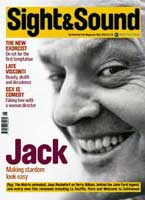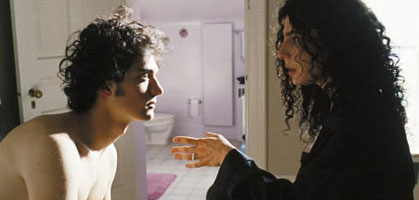
Ararat
Canada/France 2002

Reviewed by Peter Matthews
Synopsis
Our synopses give away the plot in full, including surprise twists.
Toronto, Canada, the present. Celebrated film-maker Edward Saroyan (Charles Aznavour) arrives to shoot an epic that will depict the events surrounding the Turkish massacre of more than a million Armenians in 1915. At the airport he is questioned by customs officer David (Christopher Plummer), who objects to the pomegranate in his luggage. Back home, David has trouble accepting the gay relationship between his son Philip (Brent Carver) and Ali (Elias Koteas), a struggling actor. Art historian Ani (Arsinée Khanjian) specialises in the work of Armenian painter Arshile Gorky (Simon Abkarian). Her son Raffi (David Alpay) has become sexually involved with his stepsister Celia (Marie-Josée Croze), who blames Ani for her father's death. Celia urges Raffi to discover his roots by visiting the Armenian homeland.
In a flashforward, David interrogates Raffi about some film canisters he has transported from Turkey. Raffi claims they are pick-up shots for Saroyan's epic. In a flashback to 1912, eight-year-old Arshile Gorky (Garen Boyajian) poses for a photograph the image will inspire his 1934 work 'The Artist and His Mother'. Ani's lecture on this painting is disrupted by Celia. Also in attendance is Saroyan, who decides to include Gorky in the story and hires Ani as a consultant. Shooting proceeds with Hollywood star Martin in the lead role. Ali is cast as Jevdet Bay, governor of Van, an Armenian-populated city held under siege by the Turks. In the movie, the Armenians send Arshile and other children on a mission to inform the American consul of their suffering. They are intercepted by Bay, who tortures and kills many of them. Employed as a driver on the production, Raffi returns Ali to his hotel and the two discuss the genocide. The half-Turkish Ali isn't sure it happened. Raffi reveals his father was killed by the police while attempting to assassinate a Turkish diplomat some 15 years ago. After another confrontation with Ani, Celia tries to slash Gorky's famous painting, but is stopped by gallery attendant Philip. David tells Raffi he knows about his father's terrorism and Celia's drug-dealing. Later he cross-examines Ani over the phone. When it becomes evident that she is on her way to the premiere of Saroyan's film, Raffi's story about the pick-up shots is shown to be a lie. David opens the film tins and finds a cache of heroin. Raffi is nonetheless released. Celia goes to prison. In 1912, young Arshile's mother sews a button back on his coat.
Review
In one scene of Ararat, a character notes Hitler's reported certainty that he could get away with race murder, for "who remembers the extermination of the Armenians?". If the death camps have nonetheless survived the vagaries of historical consciousness, that's partly due to their regular portrayal in movies such as Schindler's List. By representing the 1915 Armenian genocide (over a million killed) on celluloid, writer-director Atom Egoyan wants first of all to pay its victims the honour of simple recognition. The film should find a healthy niche market in the diaspora, but elsewhere will probably succumb to the same collective apathy it identifies. Precisely because the world has averted its gaze for so long, the subject matter is bound to strike most audiences as too arcane and specialised. Nor does Egoyan much improve the situation with an approach that suggests cramming for an exam. Didactic, talky, often turgid, Ararat exhibits a haughty indifference to the ordinary sources of cinematic enjoyment most blatantly in the scenes where we are compelled to listen while the actors deliver scholarly lectures or recite from books. Like the mountain of the title, the movie is uphill work; and some audiences will feel outrageously imposed upon. A few hard cases, however, may experience a nostalgic twinge for the analytical severity of Godard or Chris Marker and regard the difficulty as both a privilege and a rare pleasure.
Yet Egoyan isn't quite so uncompromising as to renounce showmanship altogether. The actual plot centres around the shooting of a grandiose studio epic about the genocide also called Ararat and this metanarrative device allows plenty of scope for battles and galloping horses. Though the US distributor Miramax must have been grateful for this, Egoyan is less interested in eye candy than in epistemology. Time and again, we're lulled into involvement with the spectacle, then brought up short by the sight of cameras and busy technicians. It's a neat if familiar piece of Brechtian shtick that inevitably questions cinema's founding illusionism. But Egoyan is no sour, postmodern demystifier. For in empowering these flat, mechanical shadows with life, we perform a necessary act of transcendence. Ararat is a plangent meditation on the hunger for meaning that impels the human soul the fragile truths we cling to, the myths that keep us going. With its despicable Turkish army officers and heroic children sent on a doomed mission, the interior Ararat is obviously designed to pastiche Hollywood's reductive treatment of history. The lumbering footage we sample hardly rates the standing ovation it's shown to receive at the premiere. But who is to judge? The largely Armenian audience makes a leap of faith and sees something else the very image of its martyred ancestors, direct testimony from the past to inspire a fractured community with a sense of roots and proud nationhood.
The blockbuster is one partial and contestable version of the tragic events. If Ararat seems heavy with melancholy, it's from the feeling that history is infinitely up for grabs. Ruins may be the result of natural erosion or wilful desecration, one man's terrorist is another's freedom fighter, while the Turkish government still won't officially concede that the Armenian holocaust happened. Cast adrift by this legacy of doubt, the characters fashion ad hoc realities based on emotional need unable to bear her father's equivocal death, for instance, Celia gives it the intentionality of murder. As in earlier Egoyan pictures like Exotica, the people are sealed within their competing monomanias. The symbolic communion of art offers some hope in healing the breach. So does basic human trust. When customs inspector David chooses to believe young Raffi's meandering tale about the contents of his film tins, it carries the same force of spiritual redemption as Nicole's white lie in The Sweet Hereafter. Admittedly, Egoyan's dramatis personae are more like the opposed terms of a dialectic than animate beings alone among contemporary directors, he has turned rigid schematism into a style. And though his aim is to demonstrate how the original crimes blight succeeding generations, there's a ludicrous disproportion between ethnic cleansing and the existential quandaries of a few well-heeled Torontonians. Yet Egoyan creates a dense system of poetic correspondences by editing across time frames, and the impression one has of archetypes (a mother's love for her child, a humble pomegranate) echoing through the ages is irresistibly poignant. In structure, Ararat resembles a tapestry static but finely woven and a rich object to contemplate.
Credits
- Director
- Atom Egoyan
- Producers
- Robert Lantos
- Atom Egoyan
- Screenplay
- Atom Egoyan
- The historical events in this film are based on Clarence Ussher's eye-witness account of the Armenian genocide of 1915, published as An American Physician in Turkey
- Director of Photography
- Paul Sarossy
- Editor
- Susan Shipton
- Production Designer
- Phillip Barker
- Music/Score Producer
- Mychael Danna
